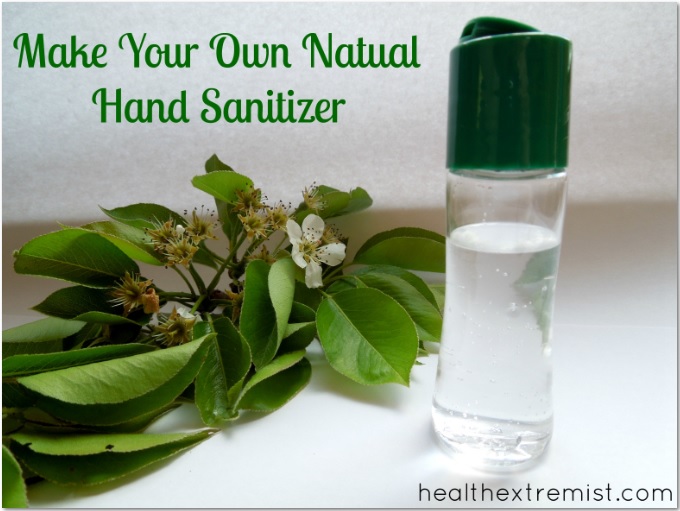This post may contain affiliate links. Please read my disclosure.
 How to Make Hand Sanitizer
How to Make Hand Sanitizer
I’ve always been concerned about trying to prevent catching a virus or the flu. However, I wouldn’t really consider myself a germaphobe because I’m not obsessed with cleanliness, I like dirt (earthing) and don’t even take a shower every day! To prevent the germs, I would carry around a container of hand sanitizer in my purse to use when needed. Even though I would much rather just wash my hands with (natural) soap and water, sometimes that’s just not an option. Even when near a restroom, I am not one to use the soap provided, who knows what types of chemicals are in it?!
Chemicals in Hand Sanitizers
Commercial hand sanitizers can actual cause more harm than good as they are packed with toxic chemicals. The chemicals can be absorbed through the skin and cause serious health effects.
The most harmful ingredients to watch out for include Triclosan, Fragrance, Parabens, Formaldehyde and Phthalates, all of which have been labeled as possible carcinogens. There’s also the issue of hand sanitizers containing alcohol, if you are looking for one that is alcohol free, this recipe is a great solution!
How to Make Hand Sanitizer
Why this recipe works:
The main ingredient in this homemade hand sanitizer, that helps fight germs and viruses, is tea tree oil. Tea tree oil is a powerful antiseptic which is why it only requires a few drops. It is antibacterial, antimicrobial, and antiviral, which makes it a great all natural alternative to alcohol based sanitizers. The tea tree oil also acts as a natural preservative, which allows this mixture to last for at least several weeks.
Ingredients:
- 8 Tablespoons Aloe Vera Gel
- 16 Drops of Tea Tree Oil
- 10 Drops of Lavender Essential Oil
- Optional: Add a few drops of other essential oils such as thyme, lemon, or orange
Instructions:
1. Mix all ingredients in a dish
2. Pour into a spray bottle or squirt bottle to use on the go
3. Shake before applying
*This recipe makes a small batch, just the right size for a small container to carry on the go. You can double the amounts for a larger amount.
Do you use hand sanitizer?


I make a bug bite soother with the same ingredients, using alot more aloe. It works for most skin irritations, rashes, eczema, burns etc!
I’ll have to try it for bug bites 🙂
I made this about a week and a half ago, and it has turned a light brown color. Does this mean it has gone bad already?
It might be if it changed color. I make mine in smaller batches and keep it for about a week.
Thanks for sharing. I have all the ingredients too!
At work I usually use hand sanitizer. I want to use a natural sanitizer. I am glad to read this article and I will definitely make my own hand sanitizer one of these days. -http://www.gillco.com/
I’ve found a lot of useful articles on your website Lori, thanks.
I’ve used a simple hand sanitiser particularly when on public transport. It is a simple saline solution. I make up 500 mls at a time with enough sea salt so it tastes salty. Then I add it to folded wipes in a very small container, and replace them as needed.
Salt has been used as a steriliser for centuries and it was recommended to me by an immigrant doctor.
I also use it as a tooth powder with half as much dolomite powder added.
Thanks for sharing 🙂
Hi there ,
I’m highly interested to make this product and thinking of selling it as well , the question is, do you know the percentage of bacteria being killed with this hand sanitizer, as opposed to what sold in the market says that it kills 100% of bacteria, can you give me the argument to counterattack the cons?
Thank you!! I LOVE YOUR Website!
Thanks Maria! Unfortunately, I can’t test it myself, but you can research the amount of bacteria the percentage of tea tree oil kills. This site has some information: http://nccam.nih.gov/health/tea/treeoil.htm
Good old fashioned soap and water, when you can use it, still is the best. The commercial hand sanitizer’s just crack and dry my skin. OK at a pinch if you are in a foreign country and no bathroom in site.
I make a larger recipe to fill bottles for my family, but I add a drop of coconut oil to mine for moisturizing. Makes it nice and creamy and absorbs quickly.
That sounds like a great addition! Thanks for sharing!